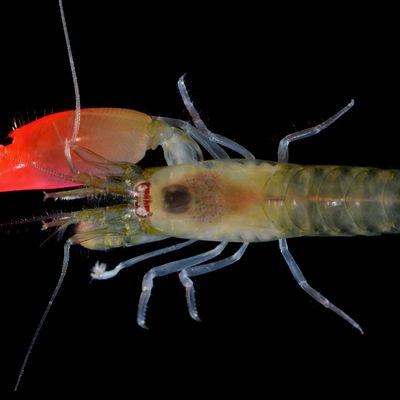
Netflix’s action movie Project Power has given the world a new (if underwhelming) superhero — the pistol shrimp. In a story about pill-activated superpowers inspired by myriad animal DNA, it’s the pistol shrimp–like power within Jamie Foxx’s character that [spoiler ahead] allows him to vaporize bullets and obliterate his enemies with one powerful pulse in the movie’s over-the-top finale. The scene is, in part, based on the incredibly real abilities of the one-to-two-inch-long organisms, who can generate a high-speed water jet to stun and annihilate any threats — and who also happen to be one of the loudest creatures in the world. We spoke to Les Kaufman, professor of biology at Boston University’s marine program, about the film’s attempts to make pistol shrimp powers human-sized. Is the movie’s portrayal of underwater snapping accurate? Kind of. Should you be impressed by the minuscule crustaceans? Definitely.
How does the pistol shrimp’s power work?
The power for which they are named involves their pincers (claws). One claw is modified with a plunger that fits into a socket. It is a little bit like a pop-it bead — out front of the socket there is a groove for a jet of water to escape when the pincer is suddenly closed. The jet is extremely powerful and causes the formation of a cavitation ring. The likely physics of this are described very well in this article. When the mechanism is activated, there is a very loud popping or crackling sound. Imagine how loud the sound would be if the shrimp were much larger!
By the way, both pistol shrimps and mantis shrimps create cavitation bubbles that are so powerful that they reach temperatures almost as high as those on the surface of the sun, resulting in a glow (sonoluminescence). But the glow is too faint and fast for us to see without the help of special instrumentation. Pistol shrimp use their power defensively, and possibly also in competition.
What would human-sized pistol shrimp powers actually look like? Does the movie seem off or on-target about it?
If human-sized, the pistol mechanism would still work, but it might be hard to make it proportionately as powerful because at the larger scale a great deal more force would be required to have the same effect. The problem is similar to that of movies about immense insects. They would either look very different than they do as teensy guys, or they would simply collapse under the weight of their exoskeletons.
Is the pistol shrimp secretly the most powerful animal (by scale)?
Hmmm. Well, first of all, its power is no secret to those in the know! All you have to do to hear about it is immerse your head in the shallows of a tropical ocean, preferably near a healthy coral reef, and there’ll be no doubt. The normal background sound is a loud din of crackling and popping — the social life and strife of all the pistol shrimp in the vicinity playing out for you in surround-sound!
As for power, there are many herculean lilliputians. The mantis shrimp would be a marine contender for sure, especially the so-called “smasher” types. Of course we all know about the seemingly disproportionate strength of ants and other small arthropods. So really, because of the way scaling works, just being tiny makes amazing things happen. Think of it like being born on the planet Krypton and then traveling to Earth.
Foxx is tired, basically dead, after doing his form of supercavitation. Does the pistol shrimp suffer the same fatigue after using it?
No, at least not right away. They can snap multiple times in succession. But if they were the size of Jamie Foxx it would be a different story, so in a sense, this might be accurate.
You said that pistol shrimp possibly use the power in competition. How so? Do they use the power against each other?
For a snapping shrimp — especially a male — the snapping power is critical to the defense of its hard-won and hard-worked burrow. The burrow is sexy. And size is sexy. To have a burrow and keep it against competitors, you’ve gotta be snappy — and the bigger your claw, the bigger your pop. Trying to invade a well-defended snapping shrimp burrow is like having a flash-bang thrown in your face. One after another! Not inviting.
Do pistol shrimps have any other powers?
There are a great many species of pistol or snapping shrimps, and they exhibit many powers! For example, pistol shrimps exhibit extraordinary social awarenesses and propensities. Some live in ant-like colonies. Others live symbiotically with sea anemones. The anemone provides protection, and the shrimp … well, not clear what the shrimp does for the anemone. Other pistol or snapping shrimps live in pairs, with fishes called gobies. Usually a pair of shrimp are responsible for creating shelter burrows in sand, while the fish, which has better vision in many ways, stands watch for danger at the entrance of the burrow. Pistol shrimps are also phenomenally diverse — they may be the most diverse of all the decapod (ten-limbed) crustaceans.
Is the pistol shrimp’s ability a well-known fact in the marine biology world?
We love the buggers. But like I said that isn’t the only special thing about them. They are everywhere in marine environments, especially in warm waters. They live inside of other things, like corals and sponges. Some of the ones that live in sponges have social societies, like those of social insects (ants, bees, wasps, termites) and mammals (naked mole rats). They are eusocial pistol shrimps.
Can the pistol shrimp and its cavitation be traced to a previous organism in evolution?
Within the pistol shrimps, there is a very interesting evolutionary story that is told here. Basically, the full-blown weapon appears to have evolved once, but the tinkering around evolutionarily with the bits and pieces that all together led to it has appeared multiple times independently. So, a period of experimentation followed by an explosively successful (many hundreds of new species) innovation. Interestingly, preceding this innovation came another — a hood over the front of the carapace, possibly protecting the eyes. One hypothesis is that the protective hood made the pistol possible by protecting the peepers.
Are there any other shrimps or other sea creatures that use cavitation bubbles similarly?
Mantis shrimps, but in a different way. There are two basic categories of mantis shrimp armament. One type is called a spearer. The end of their appendage is a sharp spear (needle-sharp!) usually with lots of smaller needles behind it on the inside of the “forearm.” The most spectacular of all is the rainbow smasher. Smashers have a swollen “elbow.” They swing their appendage forward with enormous velocity and hit something — generally a snail shell — with immense force. We divers sometimes call smashers “thumb-splitters.” Guess why. You really do not want to be on their business end. I had one in an aquarium that made me extremely nervous when it would smash the front pane of the aquarium, and they’ve been known to split an aquarium glass, which of course could be suicidal for the shrimp.
Do the pistol shrimps and the mantis shrimps share the same space?
Yes, mantis shrimps and pistol shrimps are widely sympatric and often live in close proximity, but I do not think they pay much attention to each other.
Would you recommend pistol shrimps for aquarium collecting?
Pistol shrimps are popular in the marine aquarium trade because they are beautiful, small, relatively easy to care for, and exhibit fascinating behaviors. You can keep shrimp gobies and their shrimps in an aquarium, for example, and they’ll do the whole deal.
If you could have the power of any animal, what would you go for?Definitely the wings of a bird. But still with opposable thumbs and a prefrontal cortex. Kind of sounds like a parrot, no?
This interview has been edited and condensed for clarity.






